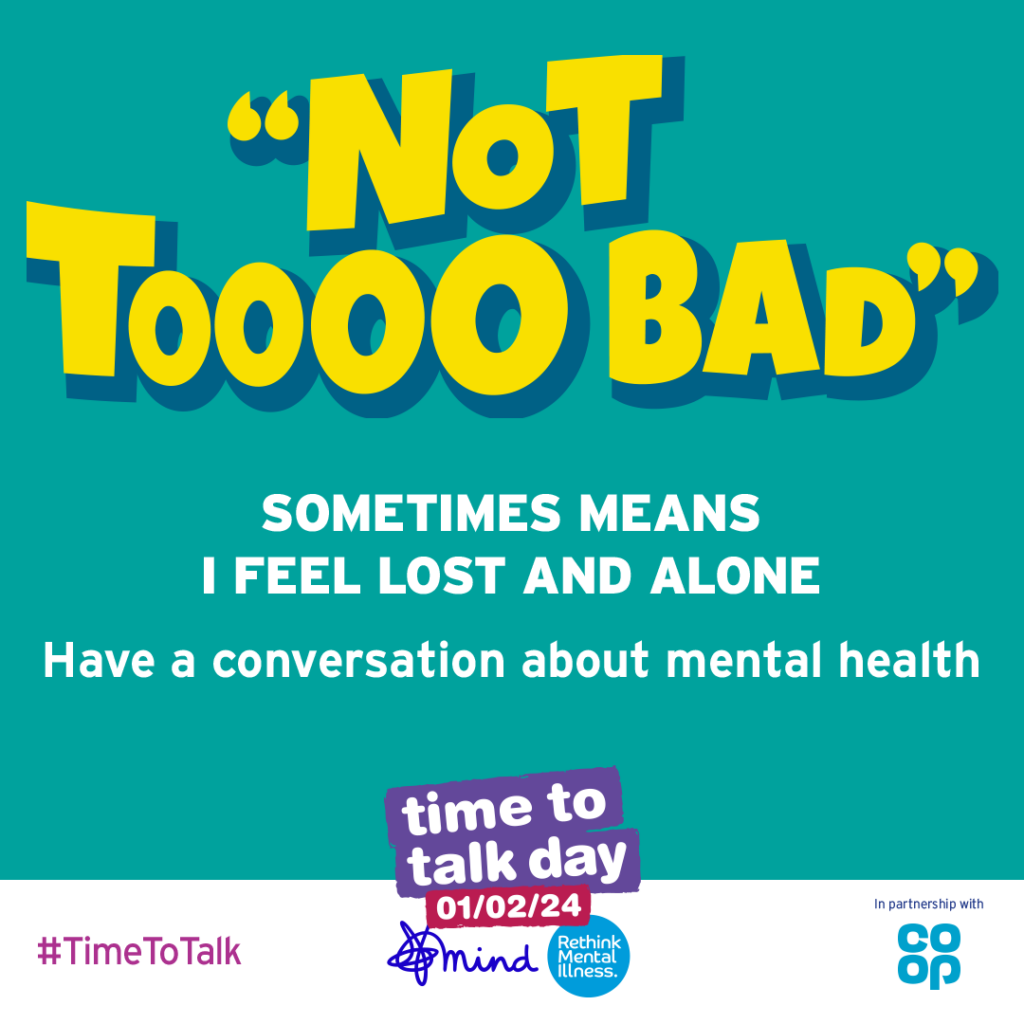Talking is OK but who is listening? Researchers are referring to teenagers today as “Generation Deaf” because of persistent earbud or headphone use is damaging their hearing.
Are we becoming a society for the “hard of hearing”: not wanting to know from other people: “what’s on your mind”?
Feeling lonely and misunderstood, leads people to swipe, tap, and click again and again. Posts that are neutral don’t go viral. Many bloggers and the rebranded “X twitters”, tend to believe the virtual world is entitled to their opinion. This is “megaphone” speaking without the button to press that’s says “I am just listening”.
Many people are lonely, not because they are alone. “I’m surrounded by people every day but I feel disconnected from them”. “I have no one with whom I can share my thoughts and feelings”.
Time to Talk Day is an annual Mental Health awareness day organised by Mind and Rethink, in partnership with the Co-op, held at the beginning of February. It’s a day for us all to start a conversation about Mental Health. That kind of conversation has the power to change lives.
“You’re not listening“. “Let me finish I“. “That’s: not what I said” are among the most common criticisms in close relationships.
When was the last time you were 100% listening, without being occupied with thoughts about what you wanted to say ? To actively listen means being “fully present” in the conversation. To concentrate on what is being said, understand what they’re saying and reflect on what’s being said.

How often do you actively listen to other people ?
To listen and “emotionally attune” to what they are saying happens less than 5 percent of the time. Listening to people’s emotions can transform your understanding of the people and the world around you, Talking about mental health isn’t easy. But a conversation where you listen with your “emotion antenna” switched on, has the power to change lives. Listening is how you form emotionally meaningful relationships.
If you were really honest with yourself, how often are you just too busy to listen or just couldn’t be bothered ?
Is not a quick text, facebook message or tapping into WhatsApp much more effective ? Let’s be blunt: we all ignore messages if it was uninteresting or delete the message if it is uncomfortable.
Poor listeners are everywhere in our lives. Just take a moment, think back over the last week and search for examples where people are having conversations with you:
Their eyes look empty and uninterested whilst you are talking. They finish your sentences for you or nod very quickly to speed the conversation. They interrupt because they have thought of something you really need to hear. They mechanically respond but show no real understanding of the points you have made. Even worse, they look over your shoulder to see if there is someone else they could be talking to.
When people do not listen to you in a conversation, how do you feel ?
When you are speaking to people, are you tempted sometimes without thinking, to promote yourself as being powerful or important ? Do you when sharing an important point, get that overwhelming urge to give way too much detail ? Then feel embarrassed because they clearly are looking bored.
Have you ever been deeply engrossed in a conversation and got so distracted by your own thoughts that it was like you put the other person on mute? Your brief absence from the conversation was caused by the fact that we can think a lot faster than someone can talk. The average person talks at around 120-150 words per minute, taking up a tiny fraction of our mental bandwidth. so we wander, thinking about a multitude of other things; which keeps us from focusing on that conversation. When we are not listening, we Interrupt and responding vaguely or illogically to what was just.
When I am relaxing with people I know at home and the TV is on, volume is low but the conversation is high. Sometimes, something on the TV captures my attention and I switch to listening to the TV. A person may be having a conversation with me but they notice that I am not giving them attention. They ask me in a slightly raised annoyed voice: “did you hear what I said ?” I resist the impulse to press the TV control device “mute button” towards them, so they speak but remain silent and say “yes”, looking interested. They then say “OK, what did I say ?”. The game is up. I have no idea. So I mute the TV and look embarrassed.
If I was paying attention and actively listening, I would try to damp down any internal distractions and be in a quiet place where there are no external distractions. So what would be my answer then if the person asked “OK, what did I say” ?
Paraphrasing is repeating back your understanding of they were saying in your own words. This gives evidence to the person, that I have been listening, with effort. That’s active listening rather than passive listening. The speaker feels heard and helps me to adjust my frame of reference. This is my way you seeing the world and others that live in it. Active listening switches off my frame of reference, allowing me to enter theirs.
Hearing is passive: Listening is active. Passive listening is one-way communication where you do not provide feedback or ask questions. You do not take action but instead let things happen to you, Active listeners focus their attention and other senses on what they see and feel . That means physical energy and mental processing. Your brain has to work hard to process all that incoming information and find meaning. That why social conversations are light, superficial and enjoyable. The conversation avoids the heaviness of sharing deep emotions. We may give our opinions and others will compare their opinion to what being said. Mental Health conversations are different, we have to hold back our judgements and listen without judgement.
To actively listen is to figure out what’s on someone’s mind and visibly show them that you care enough to want to know. It’s what we all crave: to be understood. Listening requires, more than anything, curiosity: a strong desire to know or learn something. Everybody is interesting if you ask the right questions. If someone is dull or uninteresting, it’s probably you.
Thinking you already know how a conversation will go, kills curiosity. Rapidly firing people with appraising and personal questions like “What do you do for a living:?” or “Are you married?” is interrogating. You’re not trying to get to know them. You’re sizing them up. It makes people defensive and will likely shift the conversation to a “self-promoting elevator pitch”. An elevator pitch is a brief (think 30 seconds) way of getting across a key point or two and making a connection with someone. You are with someone in a lift, going up to the same floor. You press the up button, you have the time it take to get to the floor to make those key points. That’s means developing the skills of “smart brevity”.
People tend to lose their curiosity with each other. They just become convinced they know each other better than they do. We establish, grow and maintain friendships through “everyday talk.” Without consistent contact and active listening, they deteriorate and fade. Staying in touch and keeping up with your friend is nothing more than listening to what’s on their mind.
The more you do this is like gardening, nurturing your friendship keeps “nature growing and blooming.”
If you are having a conversation with a friend, you take turns speaking. Think of turn-taking in that conversation as a tennis game, your friend says something (hits the ball away) and then you say something (hits the ball back). Half listening is like keeping one arm pinned to your side so the ball sails ‘right past or bounces clumsily off you. A good listener, by asking a question or two, can respond more sensitively and specifically.
Keeping your minds on listening mode is the constant urge to think about what you are going to say. when it’s our turn. It’s easy to send to the “silence bin”, the thought of “what am I going to eat later” ? it’s much harder to stop mentally preparing for what you are going to say when they naturally stop and its your turn. Imagine a conversation where these “preparation thoughts” visually pop up as a speech bubbles during the conversations. What would happen to the conversation ? It would collapse into a negative insensitive conversation.
Conversational sensitivity is a forerunner to empathy. To actively listen is to note feelings that bubble up. We often miss lies, as well because when someone says something that doesn’t make sense, most of the time, we don’t stop the conversation and say, ” I don’t understand.” In everyday conversations, we often shrug our shoulders because it doesn’t seem worth the embarrassment of appearing stupid.
People are comfortable with different ranges of silence: from one or two seconds up to a couple of minutes or more. Some people will be comfortable talking over each other, so there is never silence.
Everybody seems to be looking for a little peace and quiet these days. When was the last time all around you was absolute silence ?
During a walk in the Cumbria countryside ?
But nature and the wind will be present. The quietest place on earth, an anechoic chamber at Orfield Laboratories in Minnesota, is so quiet that the longest anybody has been able to bear it is 45 minutes. High tolerance for silence is a rare quality, particularly in Western cultures, where people get extremely uncomfortable when there are gaps in conversation. It’s called “dead air”.
Here is a challenge for you. Try being silent for a day, only speaking when someone invites you to say something. You will learn the unimportance of your words and the importance of other people’s words.
A hesitation or pause in western culture is seen as awkward and actively avoided. The times people began talking before the other person stopped talking is around 0-200 milliseconds, which means there was no pause at all between speakers or there was a pause that lasted less than the blink of an eye. People in Japan, allow longer gaps in conversation.
In Western cultures, people tend to interpret silences longer than about half a second as disapproval or social exclusion, so they automatically rush to say something positive about themselves. A silence of just four seconds is enough for people to realise their views are out of line. There are times when silences mean disapproval. Think of the silence after someone tells an inappropriate joke. There’s a big difference between being “silent with” and “being “silent to,” just like there’s a big difference between “laughing with” and “laughing at.”
People universally don’t like loss of conversational flow. If the silence goes on too long, longer than what the norm is in that culture, it makes people uneasy. Being able to comfortably sit in silence is actually a sign of a healthy Mental Health conversation. People pause while figuring out what, or how much, to tell you, or perhaps they need a moment to manage their emotions. Just wait. Give the other person a chance to pick up where they left off.
Sometimes, it takes more than one conversation to hear someone. Listening can continue even when you are no longer in the presence of that person as you reflect on what was said. When you reflect on what someone said, their thoughts and feelings become part of you.
Listening is like playing a musical instrument in that you can get much better with practice, but you will never achieve total control.
- Some may have more natural ability
- some may have to try harder
but everyone can benefit from making the effort.
How about you ?
A recommendation for your reading list – you’re not listening by Kate Murphy many themes from this book have helped inspire the article.
written by Chris Graham* views expressed employees own

















